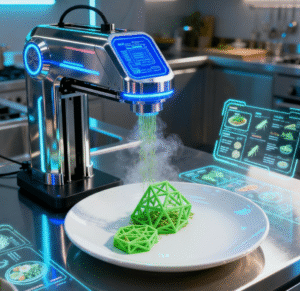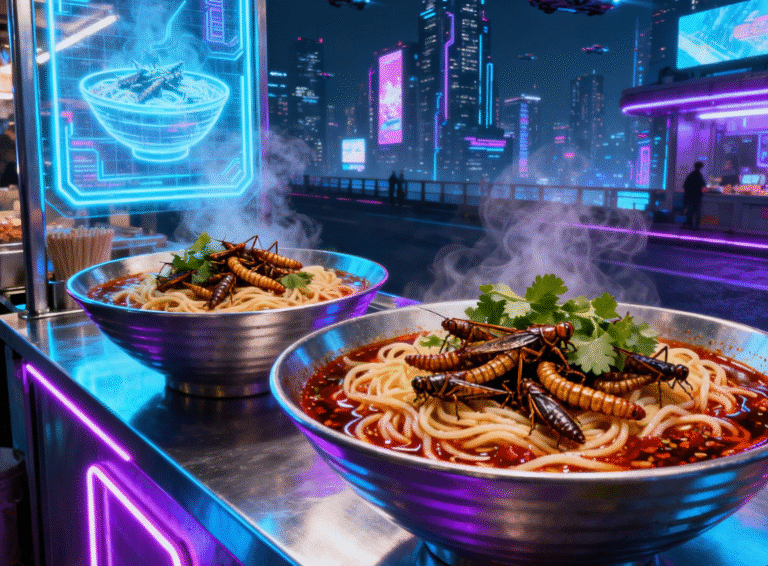In the neon-lit worlds of my novels, street vendors fry cricket kebabs under flickering signs, and mega-corporations pump out soldier fly larva paste by the ton to feed millions of people. It’s not a culinary gimmick — it’s survival engineering. In the imagined future, insect protein stands as the last resilient food source in an ecologically gutted world. The irony, of course, is that reality is catching up. As climate change strains traditional agriculture, scientists and entrepreneurs are turning toward the same idea: bugs as food.
Today, insects like crickets, mealworms, and grasshoppers are being sold as high-protein flour or snack substitutes in markets from Bangkok to Berlin. They’re not just novelties — entomophagy (the practice of eating insects) is becoming a serious component in discussions on sustainable food systems. Studies show crickets, for instance, are up to 60–70% protein by weight and provide iron, zinc, and vitamin B12 in substantial quantities. This puts them on par with — or even above — many traditional meats in nutritional density.
But beyond nutrition, insect farming shines in its environmental efficiency. Producing 1 kilogram of beef demands roughly 25 kilograms of feed, while crickets need just 1.7 kilograms for the same protein yield. They also consume minimal water, take up virtually no arable land, and can thrive on organic waste streams. With their quick reproduction cycles and low emissions footprint, insects have emerged as one of the most promising sustainable protein sources on Earth.
That’s why in cyberpunk fiction and scientific reality alike, they’ve become symbols — not just of adaptation, but of redefinition. What was once a desperate vision of future scarcity has become a potential solution to today’s food crisis. But maybe the real question isn’t whether insect protein can sustain humanity — it’s whether humanity can stomach it. And that tension between innovation and revulsion is where the science and storytelling collide.
Insect Protein in the Hope Cyberpunk Universe
There’s something poetic about that reversal of hierarchy — humans relying on the tiniest, most overlooked creatures to endure. In scenes set across neon sprawls or sparse wastelands, insects become both food and metaphor. Cricket farms hum under ultraviolet lights, mealworms are fattened on discarded cellulose, and grasshopper flour is extruded into nutrient bars for street kids to buy from vending machines. Bugs symbolize two competing forces: ingenuity and desperation. They represent our adaptability when the world demands a change.
That fictional world, as it turns out, isn’t far from the laboratory work being done right now. Food scientists are coming to the same conclusion that diners in Hope Megacity did — bugs work. According to research from Jiangsu Ocean University, edible insects are extremely resource-efficient, requiring nearly one-eighth of the land used for cattle and converting feed to protein up to twenty-five times more efficiently. Crickets, mealworms, and black soldier flies can even thrive on agricultural or food waste, turning scraps into nutrient-rich biomass. Their waste, in turn, fertilizes future crops, completing what scientists call a “circular food economy.”
In the dualistic realism of my cyberpunk worlds, this kind of closed-loop efficiency is survivalist design at its best — nothing wasted, everything repurposed. In my mind, it was a pivot on the idea of junk food. How do you make cheap, plentiful, colorful, flavorful crap that everyone wants to eat — but make it far, far healthier than a bag of Cheetos? You make it out of bugs.
But it’s also an echo of real-world sustainability science. Insects capture the dream of infinite recyclability, of reusing waste and turning entropy into nourishment. The difference, of course, is tone: my characters feed on them out of necessity, but in 2025, we still have a choice. That tension — between dystopian pragmatism and ecological optimism — is exactly what keeps the idea crawling out of fiction and into the kitchen.
The Science Behind the Crunch: Why Insects Work
The old ways of eating are collapsing under their own weight. Unfortunately, we can’t afford to see “sustainability” as another virtue signaling word or something that’s just there to be exploited for tax credits. At the end of the day, we all have to eat. If there was ever a great equalizer that should reach across the aisle, it’s food.
According to the 2025 Global Report on Food Crises, over 295 million people across 53 countries are facing acute food insecurity — double the number since 2020. (World Bank Group)
Insects are remarkably efficient at turning feed into protein. A study published in Frontiers in Sustainability notes that crickets can gain a kilogram of body weight on less than 2 kilograms of feed, compared to 2.5 kg for chicken, 5 kg for pork, and up to 10 kg for beef. Up to 80% of a cricket is edible, while only around 40% of a cow makes it to the table. That means fewer resources, less waste, and higher yield per organism. In an era when climate, water, and land are running out, that’s more than an advantage — it’s a necessity.
Environmental analysis from Animal Frontiers shows that farming insects could reduce greenhouse gas emissions from protein production by 72–97% compared to beef and slash land use by up to 96% if insects were scaled efficiently. Even their waste isn’t waste — frass, aka insect poop, doubles as a potent organic fertilizer in regenerative farming systems. If raised on organic leftovers or food waste, they not only recycle but actively clean up parts of the agricultural chain.
Nutritionally, most edible species — crickets, mealworms, locusts, and black soldier flies — contain between 40% and 75% protein by dry weight, along with beneficial fats rich in omega-3 and omega-6 fatty acids. They also supply micronutrients such as iron, zinc, potassium, and vitamin B12 — nutrients often deficient in low-meat diets. Insects, essentially, pack a biochemical résumé that puts them in direct competition with conventional meat.
In the systems of tomorrow — whether designed by fiction or policy — the real miracle isn’t that we can eat insects, but that they give back more than they take. They embody a minimalism that modern food production desperately needs: less methane, less land, less water, more protein. They’re not just the protein of the future; they’re the efficiency algorithm made edible.
The Challenges and Risks
Of course, the story isn’t all peaches and beetles. For all their promise, edible insects come bundled with loads of regulatory, biological, and psychological complications. The science might be catching up to the hype, but the logistics and the biology aren’t always cooperative.
At the most basic level, large-scale insect farming still sits in murky territory. While crickets, mealworms, and black soldier flies are efficient protein converters, the sustainability of these systems isn’t yet guaranteed at industrial scales. According to recent analyses in NPJ Science of Food, feed substrates — the organic materials used to grow insects — represent one of the biggest environmental and safety challenges. If those substrates are contaminated with heavy metals, pesticides, or pathogens, the insects can bioaccumulate those hazards, passing them up the food chain. Some species like black soldier flies can neutralize certain toxins, but others, such as mealworms, may retain lead or arsenic deposits from tainted feed.
There are also microbiological risks. Studies have detected bacteria such as Salmonella, Enterobacteriaceae, and Bacillus cereus in farmed insects, especially when improper handling, storage, or “crushing” steps release gut microbes into the product. Processing methods like drying or roasting can eliminate most pathogens — but not all. European regulations now classify farmed insects under the same hygiene standards as livestock, requiring strict monitoring at every stage of production. That kind of oversight is still in its infancy, and many small-scale producers lack the infrastructure to meet it.
Then there’s the allergenic puzzle. Research published in Critical Reviews in Food Science and Nutrition reveals that insect proteins share structural similarities with crustaceans and dust mites — particularly tropomyosin and arginine kinase, which are known triggers for allergic reactions. In human trials, insect protein performed comparably to milk, soy, or beef for nutrient absorption, but allergic cross-reactions remain a concern, especially for individuals sensitive to shellfish. Some heat treatments can reduce allergenic potency, but there’s no universal fix.
Finally, the cultural hurdle remains formidable. In Western countries, insect consumption still battles disgust and stigma. To many, bugs are pests, not proteins. As a result, most edible insect products in Europe come in powdered or extruded forms, hiding in protein bars, pasta, or baked goods rather than sitting whole on dinner plates. While this distances consumers from facing what they’re eating — it also opens the door to fraud and mislabeling in increasingly complex supply chains.
So even if the numbers add up and the proteins stack beautifully on paper, there’s still a human bottleneck: safety, regulation, and psychology. Even if insects prove to be a perfect food, they’re far from being a perfect product.
Printing the Future: 3D Food and Insect Protein
In the Hope Cyberpunk Universe, the corporation NuFoods sidestepped a great deal of consumer rejection by processing insect protein (combined with other products like fast-growing algae) into a printable paste. While I was originally inspired by 3D printers that produce confections out of chocolate and things I learned from keeping reptiles, my futurism wasn’t far off.
Picture this: instead of frying mealworm patties in a pan, you feed a protein-rich paste into a printer. The machine extrudes layer after layer, not of plastic or resin, but of edible “ink”—and what comes out is a steak, a snack, or something entirely new. The research projects behind making this a reality are happening right now.
The U.S. National Institute of Food and Agriculture is funding a collaboration between Ohio State University and Universitat Rovira i Virgili to push the limits of how insect proteins can be processed and printed into food. Using supercritical CO₂ and high-pressure extraction, researchers are creating smooth, nutrient-dense protein and lipid fractions from crickets and black soldier flies, optimized for printability and taste. The goal isn’t just efficiency — it’s transformation: to turn a cricket into something that feels, looks, and even tastes like modern comfort food. Advanced NIR sensors and AI analytics are being developed to monitor the exact mix of proteins, fats, and chitin in real time, ensuring consistent quality while reducing waste.
Meanwhile, at Universitat Rovira i Virgili in Spain, scientists have successfully combined mealworm and locust powders with chickpea flour to print crispy, savory snacks. The dough’s elasticity, stickiness, and texture change with insect concentration, producing delicately crunchy treats that retain the insects’ nutritional benefits while disguising their origins. Taste aside, the beauty of 3D printing lies in its precision — shaping food structure to mimic familiar textures and eliminate the psychological “ick” factor.
Printing with insect-based proteins could make sustainability taste normal. It’s an elegant hack: using advanced tech to rebrand necessity as innovation. As mass production expands and consumer acceptance grows, what begins as an experiment in food labs could evolve into an everyday kitchen appliance — a culinary symbol of post-industrial adaptation. I predict that in the future, we’ll see far fewer “plant based” and “lab grown” labels, and far more that say “Eco-Protein” or whatever term the marketing guys come up with for insect-derived ingredients.
Final Thoughts on the Line Between Sci-Fi and Dinner
In my novels, the apocalypse was long and loud, but the resulting dystopia is quiet and bureaucratic. The way one led into the other is largely based around resource scarcity — food. A country that can’t feed its people isn’t much of a country, and society only holds together when stomachs are full.
So when climate change, war, and widespread tech failures cut off the food supply for billions of people, it only made sense that a conglomeration of corporations could easily swoop in and install a new world order simply by serving up dinner.
Much of this isn’t just creative license; it’s trending data. The drivers for increasing food crises are painfully familiar: escalating wars, climate extremes, and collapsing economies. Even worse, global humanitarian funding has been slashed by an estimated 45% this year.
I write about futures that I don’t particularly want to see come to reality, but some of the parallels are frightening. The Hope Cyberpunk Universe feels less like a crystal ball and more like a mirror tilted just slightly forward. And in that mirror, technologies like 3D-printed nutrition, insect protein, and closed-loop agriculture aren’t novelties. They’re lifelines. The convergence of insect farming and digital fabrication is a glimpse of how humanity might design its way out of biological bankruptcy. Not because we want to — but because the math demands it.
Maybe that’s what the future of food was always meant to be: not a return to agrarian romanticism or a sterile lab diet, but a fusion of necessity and invention. NuFoods may eventually emerge as the kitchen that feeds billions of people without burning the planet down. The question isn’t whether we’ll eat differently — it’s whether we’ll see it as dystopia or evolution.




